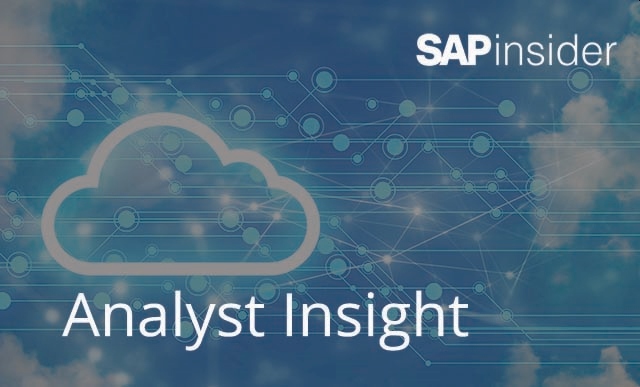Examining Public Cloud for SAP Applications
Key Questions to Ask Cloud Service Providers and the CxO
The conversation around public cloud adoption has significantly matured in recent years. The potential to reduce time-consuming, expensive tasks such as capacity planning, physical infrastructure deployment, management, and maintenance by outsourcing to a globally available public cloud is appealing. Key concerns around security are being put to rest, with insights from Gartner suggesting that “through 2020, public cloud infrastructure-as-a-service (IaaS) workload will suffer at least 60% fewer security incidents than those in traditional data centers.” The well-documented benefits of leveraging public cloud to shift from capital expenditure (CAPEX) to operational expenditure (OPEX) and enhance business agility are the key drivers for undertaking IT modernization projects, but the true value of outsourcing to service providers is to enable the business to focus on core business initiatives and accelerate innovation. Companies that move further into the cloud are finding new ways — both inward- and outward-facing — to innovate, such as by producing better user experiences and mobile solutions for a happier and more productive workforce as well as delivering innovative new applications and services for a global audience.
To maximize the benefits of the public cloud, companies need to evaluate the ecosystem of public cloud providers and make some important decisions. Many companies that have already performed a cloud readiness assessment have explored their options and are considering public cloud providers that deliver core cloud benefits at global scale with the capability to host SAP applications on SAP-certified cloud infrastructure. SUSE has been working with enterprise customers at varying stages of this journey in determining where the SAP landscape and cloud intersect — whether that means building a private cloud, or outsourcing to a managed cloud or global public cloud platform. While there are a variety of SAP-certified public IaaS platforms available that SUSE Linux Enterprise Server for SAP applications supports — including the recently announced Google Compute Engine — we’ll be closely looking at some considerations around two cloud solutions: Microsoft Azure and Amazon Web Services (AWS). Before making the move to cloud, be sure to consider your use case, the organization’s velocity for change, and the overall cloud strategy.
1. Are You Ready for the Cloud?
The most important questions to ask are around your use case. What benefits are you looking to deliver? Are you looking to enhance the user experience and performance of line-of-business (LoB) applications with SAP Fiori and SAP S/4HANA? Are you looking to derive insight from data lakes using SAP BW/4HANA? Regardless of the project, leading public clouds will help you achieve time to value in weeks without having to forecast and pay for unused capacity. It’s important that you do your research and ask yourself the important questions, both internally and externally, before moving forward.
While deploying on the public cloud to test new applications powered by SAP HANA makes for an exciting proposition, ensure that your project is well scoped, the cloud infrastructure is sized, and the applications are fully supported before moving them to production. Take note that certain regions are still rolling out the full capacity and capability of high-memory cloud infrastructure. Regardless of your project timeline and region availability, you should engage with multiple cloud vendors and understand the benefits of each offering. You should also consider whether key investments into software-as-a-service (SaaS) applications — such as Microsoft Office 365 (and a rollout of Azure Active Directory) or Google’s G Suite — have already been made, which offer valuable integration potential.
For a successful transition to the cloud, you should be able to analyze and monitor cloud spend, which can quickly ramp up if you’re not leveraging tools such as Amazon CloudWatch, AWS Trusted Advisor, or third-party solutions such as CloudCheckr, or leveraging a managed service provider (MSP) or an SAP HANA Enterprise Cloud partner. Understanding the total cost of ownership (TCO) requires a thorough investigation into the costs associated with instance sizes, scaling, and high-availability scenarios as well as the option to buy in bulk and pay upfront with Amazon EC2 Reserved Instances, Microsoft Azure Compute Pre-Purchase Plan, or your enterprise agreement.
Remember that the cloud is not a location, but a method of IT modernization to accelerate your business, enhance agility, and drive innovation.
2. What’s Your True Velocity?
If your organization is ahead of the game, then you may have already spun up X1 instances on AWS or are planning your next project in the cloud. Partners such as AWS innovate at a blistering pace and have cultivated a perfect storm for change. Over one million active customers with unique requirements are using AWS and are inspiring their roadmap. AWS instills a customer-centric culture from the top down that encourages challenging each other and lowering prices. The pace of innovation moves quickly, and it’s important to evaluate whether you have the resources and skillsets to keep up. The AWS partner ecosystem has several unique partners aligned towards DevOps delivery and enterprise companies moving at faster velocities in addition to traditional global system integrators investing heavily in their AWS competencies.
Microsoft Azure is also innovating rapidly in the public and hybrid cloud with a very strong partner ecosystem that has been helping organizations control and manage new technology adoption for decades. The Microsoft channel and partner ecosystem is built to enable technology adoption through investment in pilot projects with a pragmatic approach in their execution of engagements designed to deliver value. Working with Microsoft partners is a good option for many organizations that are already working with Microsoft and that want to modernize the SAP landscape.
3. What’s Your View on Hybrid?
It is important to understand your organization’s complete cloud adoption strategy at the onset. Is the strategy well defined from the top down? Does your pilot project on public cloud risk falling victim to a lack of executive buy-in? The spectrum of cloud strategy varies from “all-in” to “cloud-first,” but even these are nuanced discussions. You will need to factor in your organization’s propensity to build, own, and operate that cloud deployment or outsource some or all of it to a cloud service provider.
While many organizations are taking the stance that managing physical assets adds no value, repurposing hardware and maintaining data center ownership has merit — look no further than the strength of the OpenStack distribution and leading distributions such as SUSE OpenStack Cloud, for example. Investing in a private cloud enables agility for organizations with unique security or data sovereignty requirements that cannot be met by a public cloud provider. While the security and compliance levels of public cloud providers meet most requirements, a few public cloud providers are offering proprietary private cloud solutions for on premise as well. In the public cloud landscape, Microsoft Azure is a good choice if you’re looking to centralize your investment in a hybrid cloud scenario.
Microsoft’s vision of a true hybrid cloud solution, Azure Stack, provides a seamless experience of Azure that offers the control, ownership, and agility of a private cloud at a metered consumption model. It is currently in technical preview, and while you can install it and deploy SUSE Linux Enterprise Server today, it is important to note that the release date is not set in stone. Adopting AWS and private cloud capabilities, such as SUSE OpenStack Cloud, is another great route if your hybrid cloud strategy is well defined, invested in, and ready for 2017. One way or another, SUSE solutions are available across the spectrum of cloud.
Learn More
No matter where you are in your journey to the cloud, you can expect a fervent competition for your business. A handful of providers are certified for SAP applications and can provide the core capabilities to enable agility and transformative economics, but only a select few can offer a powerful suite of on-demand services, application program interfaces (APIs), and integration points to truly accelerate your digital business. Whichever you choose, you’ll find that SUSE Linux Enterprise Server for SAP applications, an operating system (OS) built for the modern SAP landscape, is available on-demand across public cloud platforms such as AWS, Microsoft Azure, and the Google Compute Engine. SUSE solutions for SAP applications will enable you to achieve the level of reliability, availability, and security you’re used to with on premise but in a scalable cloud infrastructure. Remember that the cloud is not necessarily a location, but a method of IT modernization and infrastructure consumption to accelerate your business, enhance agility, and drive innovation. To learn more, visit www.suse.com/public-cloud or email us at public-cloud@suse.com.








